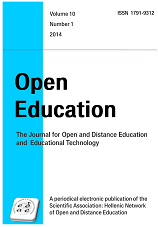Student Admission Data Analytics for Open and Distance Education in Greece
Abstract
Over the last few decades, distance learning has become very popular, as a result of the many pros it offers, along with its flexibility. The need for a better understanding of the data originating from such educational environments has led to the rise of the Educational Data Mining research field. However, most of the studies so far focus on the analysis of the data being collected during and/or after the distance learning courses. In this paper, we study the demographical data related to student applications for acceptance in distance learning programs offered by the Hellenic Open University, during the decade from 2003 to 2013. Our study aims at analyzing the data, and discovering patterns and knowledge that can be used to help the strategic placement of the university, and the improvement of the experience that offers to its students. Moreover, we attempt to correlate the discovered findings with the social and financial status of the applicants’ environment.
Article Details
- Zitationsvorschlag
-
- Ausgabe
- Bd. 13 Nr. 2 (2017)
- Rubrik
- Μέρος πρώτο / Section 1









